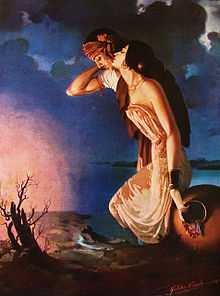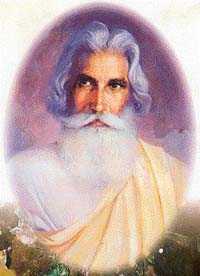Sobha Singh (painter)
| Sobha Singh | |
|---|---|
|
Self portrait by Sobha Singh | |
| Native name | ਸੋਭਾ ਸਿੰਘ |
| Born | 29 November 1901 |
| Died | 22 August 1986 (aged 84) |
| Known for | Painting |
Sobha Singh (29 November 1901 – 22 August 1986)[1] was a well-known contemporary painter from Indian Punjab.
Early life
Sardar Sobha Singh was born on 29 November 1901 in a Ramgarhia Sikh family in Sri Hargobindpur, Gurdaspur district of Punjab. His father, Deva Singh, was in the Indian cavalry. In 1949 he settled down in Andretta (near Palampur), a remote and then little-known hamlet in the Kangra Valley on the foothills of the Himalayas, beginning his career as a painter. Sobha Singh is fondly remembered as Darji and his adopted daughter Bibi Gurcharan Kaur has converted Andretta into an ever popular tourist destination not only for art enthusiasts but for all who admire his work.at the art gallery. Gurcharan Kaur's son Hirdaypal Singh now manages the SOBHA SINGH ART GALLERY, a jewel in the heart of the Kangra Valley.
Education and training
At age 15, Sobha Singh entered the Industrial School at Amritsar for a one-year course in art and craft. He joined the British Indian army as a draughtsman and served in Baghdad, Mesopotamia (now Iraq). In 1923 he left army and returned to Amritsar, where he opened his art studio. In the same year, he married Bibi Inder Kaur on Baisakhi day. He worked from his studios at Amritsar, Lahore (1926) and Delhi (1931).
In 1946, He went back to Lahore and opened his studio at Anarkali and was working as an art director for a film when he was forced to leave the city due to partition of the country.[2] In 1949 he settled down in Andretta (near Palampur), a remote and then little-known place in the Kangra Valley, beginning his career as a painter. Now these days this place is very well known.
Painting

During his 38-year stay at Andretta, S. Sobha Singh painted hundreds of His main focus was Sikh gurus, their life and work. His series on the Sikh gurus have dominated to an extent that his paintings dominate the public's perception associated with Guru Nanak and Guru Gobind Singh.
The portrait he made in honour of the 500th birth anniversary of Guru Nanak in 1969 is the one most people believe to be the visage of Guru Nanak. Sobha Singh painted pictures of other gurus as well, Guru Amar Das, Guru Tegh Bahadur and Guru Har Krishan.
His paintings of Sohni Mahiwal and Heer Ranjha were also very popular. He also painted impressive portraits of national heroes and leaders like Shaheed Bhagat Singh, Kartar Singh Sarabha, Mahatma Gandhi, Lal Bahadur Shastri etc.[3]
His murals are displayed in the art gallery of Indian Parliament House in New Delhi. The panel depicting the evolution of Sikh history features Guru Nanak with Bala and Mardana on one side; and Guru Gobind Singh in meditation on the other. Sobha Singh also dabbled in sculpture, and did the busts of some eminent Punjabis such as M.S. Randhawa, Prithviraj Kapoor and Nirmal Chandra, and an incomplete head-study of the Punjabi poetess Amrita Pritam. The originals of his works are displayed in his studio at Andretta. General public can also visit his studio in Andretta.
Sobha Singh died in Chandigarh on 21 August 1986. Andreta (Palampur) is so popular because of the Sobha Singh painter called Sobha Singh art gallery. Many of the visitors including tourists visit Andreta also.
Awards
Numerous awards and distinctions were conferred on him, the prominent being the title of State Artist of the Punjab Government in 1974 and the Padma Shri of the Government of India in 1983.[4] He was conferred upon the degree of Doctor of Literature (Honoris Causa) by Punjabi University, Patiala.[5]
The Ministry of Information and Broadcasting released a documentary film titled Painter of the People based on his life and works. The British Broadcasting Corporation also made a documentary on him in 1984. Indian Government issued postal stamp in honour of Sobha Singh in 2001.[6]
References
- ↑ ਰਛਪਾਲ ਸਿੰਘ ਗਿੱਲ (2004). ਪੰਜਾਬ ਕੋਸ਼ ਜਿਲਦ ਪਹਿਲੀ. ਭਾਸ਼ਾ ਵਿਭਾਗ ਪੰਜਾਬ. p. 430.
- ↑ S. Sobha Singh Artist
- ↑ Sardar Shoba Singh |
- ↑ The Government Museum and Art Gallery Chandigarh, India
- ↑ The Sunday Tribune – Spectrum
- ↑ The Tribune, Chandigarh, India – Himachal Pradesh
External links
- Sobha Singh page on 123himachal.com
- Page at allaboutsikhs.com
- Sobha Singh Page on Sikh-History.com
- Stamp on Sobha Singh at the Wayback Machine (archived 27 October 2009)
- Documentary Artist Sobha Singh on YouTube
|
